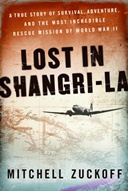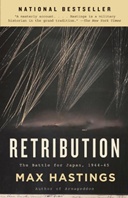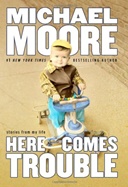“If you take a punch at me now: (1) You will break your hand. That’s the beauty of spending just a half hour a day on your muscular-skeletal structure — it turns into kryptonite; (2) I will fall on you. I’m still working on my core and balance issues, so after you slug me I will tip over and crush you.” — Michael Moore in Here Comes Trouble
 |
Lost in Shangri-La Mitchell Zuckoff A true survival and rescue story of World War II, well-publicized at the time but forgotten today, thankfully unearthed and retold by Mitchell Zuckoff. I recently read another WWII survival story, Unbroken by Lauren Hillebrand (my review is here), and based on the publicity for Lost in Shangri-La, anticipated a similarly harrowing tale. Alas, the story retold in Lost in Shangri-La didn’t live up to those expectations … or even the blurbs on the book’s jacket. The three surviving passengers of the C-47 that crashed on a remote mountainside in Dutch New Guinea during the last few months of WWII had it tough, but not really that tough. The survivors, two men and one woman, were able to hike down from the mountain to a clearing where they were seen by a search plane the following day. They were in an uncharted valley surrounded by high mountains. Aircraft could not land there, and there were no roads. Moreover, the valley was at least 150 miles from the nearest friendly forces, and an unknown number of hostile Japanese soldiers were at large in the jungle. But once the Army knew where the survivors were, it flew daily missions to drop supplies around their clearing, and after only a couple of days the Army parachuted in medics and soldiers. It took about a month, but the Army finally figured out a way to get them out. As soon as the press discovered one of the survivors was a pretty WAF, the resupply and rescue story began to receive daily coverage. Reporters turned up in New Guinea and hitched rides on resupply planes. One, an Australian movie cameraman, even parachuted down to join the survivors and soldiers in the jungle. The three survivors and their rescuers returned to the USA as heroes, just days before the atomic bomb attacks on Hiroshima and Nagasaki. Public interest in the ongoing story was fanned by sex, sensationalism, and of course racism, since the survivors were down in territory inhabited by naked New Guinean tribesmen, widely reported to be head-hunting cannibals. Mitchell Zuckoff re-creates the breathless, titillating style of mid-1940s ooga-booga Tarzan & Jane reportage, but when I finished the book I felt rather let down. Apart from burns sustained in the crash, the survivors didn’t really have it that tough. The natives were curious but unthreatening. Once the medics and soldiers joined the survivors they had a great time, with the Army flying overhead every day and dropping crates of food, clothing, shoes, even books and magazines. The most interesting aspect of the story, at least to me, was the use of gliders to extract the survivors and their support party. I had always heard that the Waco gliders used during the D-Day invasion of Normandy were designed to be reused, and that’s the solution the Army applied in this case. The soldiers who had been parachuted in cut brush in a flat area to make a runway. A C-47 towed a glider overhead and released it to land. The glider crew set up long poles, between which they strung a rope attached to the glider’s tow cable, and in came the C-47 again, snagging the rope and yanking the glider back into the air, then towing it back to the Army air base. The glider could haul out only five passengers at a time, so they had to repeat this daring feat twice more in following days to get all 15 people from the isolated valley. For an aviation buff like me, that justified the price of the book! Lost in Shangri-La is an interesting look back into wartime American culture, and the details of the rescue operation are fascinating. But overall I felt the publicity for the book was intentionally misleading. It is hardly the blonde-in-a-cannibal-stewpot tale it represents itself to be. If you’re looking for a harrowing, true-life survival story, read Unbroken. |
 |
Retribution: The Battle for Japan, 1944-45 Max Hastings I believe this is the first World War II history I’ve read that was written by a non-American author. As such, it was a revelation to me. Max Hastings confines himself to the last year of WWII in the Pacific, the campaign against Japan. But when I say “confines,” I don’t wish to be misleading — this history is enormous in scope, because Hastings includes the history Americans aren’t taught. Retribution covers the entirety of the final year of the war in the Pacific, from mid-1944 to the war’s end in August 1945: the actions of the Japanese in the countries they had invaded and occupied; the American re-invasion of the Philippines and the Navy’s island-by-island advance (including details of diplomatic, espionage and intelligence, ground, sea, and air operations); the British campaigns in Burma and Malaya; the actions of the nationalist and communist armies in China; the Australians’ reluctant participation; the Russian invasion of Manchuria, North Korea, and Sakalin Island; and as always, the relentless jockeying for supremacy between military services and rival allied military leaders. Hasting’s history is peppered with quotes and statements from people who were there — interviews, memoirs, diary entries, letters home — participants of all nations, enemy and allied, from refugees to enslaved Chinese peasants to women abducted to serve as comfort girls, from battlefield grunts and sailors to generals and admirals, from diplomats to heads of state. Hastings’ work is scholarly and thorough, yet anything but dry. Retribution is one of the most engaging war histories I have read, and probably due to my own American myopia, I learned something new on almost every page. Here’s a taste to whet your appetite: when US Army soldiers went ashore on Okinawa, during the brief lull before the Japanese began firing back, enterprising troops sewed up fake Japanese flags from parachute silk, shot them to create bullet holes, and sold them as war souvenirs to the sailors of the invasion fleet. Beyond sharing fascinating details, Hastings puts you into the mindset of the decision-makers of the time, helping you to understand why they took the actions they did by giving you the context: what was known by allied and enemy leaders in 1944 and 1945, minus the benefit of contemporary hindsight. One understands, after reading Retribution, why allied military forces showed little mercy to the Japanese, why the people of Japanese-occupied countries hate and fear the Japanese to this day, and why American military and political leaders undertook the firebombing of Japanese cities and later the employment of atomic bombs. Max Hastings has written a companion WWII history covering the last year of the allied campaign against the Nazis. It is titled Armageddon. I will certainly read it, and soon. |
 |
Here Comes Trouble Michael Moore Michael Moore presents himself as an honest and forthcoming guy, a regular fellow anyone would be proud to know, but in fact his partial autobiography gives us only a few glimpses into his life and experiences, leaving much unsaid. He tells us about his life in short chapters covering different stages of his life: we learn a bit about him as a child, a teenager, a budding politician, an underground journalist, and eventually a documentary film maker. Each vignette features a moral lesson learned, meant to show us how he developed his values and convictions. Moore isn’t afraid to reveal a few personal flaws or tell us about times when he failed to live up to his own standards (he relates one story about an incident at his high school where he should have stood up for a fellow student but didn’t) … but again, you sense he’s leaving much out and you wonder why. Just one example: he goes into some detail about his religious upbringing, even telling us about his desire to enter the priesthood and his year at a seminary school, but he implies in later chapters he’s abandoned the church … without coming out and saying so. What does Michael Moore believe in today? Does he still believe or is he an atheist? He doesn’t say, even though he begs the question by putting such stress on his early religious life. Another example: speaking of his earlier life, he describes friendships and romantic interests, but then tells us absolutely nothing about his marriage or his wife. We don’t even learn her name. One thing he makes clear about himself in every story is that he can’t resist saying what he’s really thinking. Here comes trouble, indeed … Michael Moore is a born trouble-maker, and to the extent that he’s willing to share how he grew up and learned to channel his trouble-making instincts, this is an interesting book. |